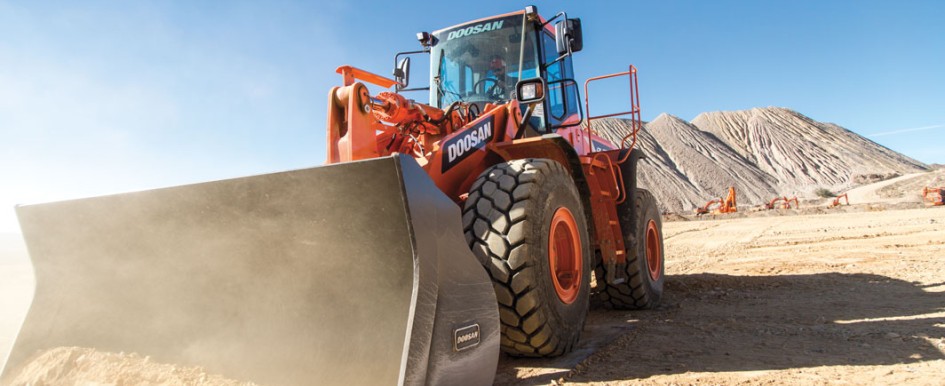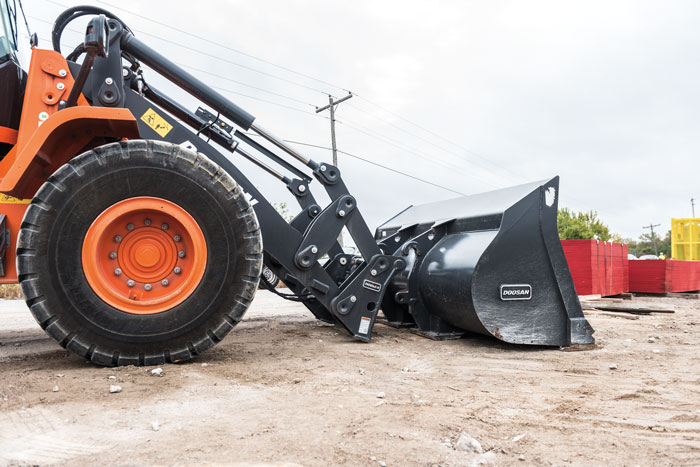
Awheel loader’s bucket is typically its biggest revenue generator. But, with many types to choose from, how do you know what type of bucket is best suited for your application? Before performing tasks like loading, carrying and stockpiling, evaluate the bucket weight, capacity and expected material density; also, understand the four most common bucket designs: general purpose, light material, multipurpose and rock buckets. In addition, consider ground-engaging tools. By specifying the right bucket, you can better meet your daily production targets and help maintain machine performance.
Determine Material Density
When sizing a bucket to your wheel loader, evaluate the bucket weight and capacity first. Start by calculating the average density of the material to be moved, and then compare that to the tipping load and lifting capacity of the wheel loader. Also, consider that you may be working with multiple densities, so specify the bucket based on the heaviest material it will handle. For instance, sand that absorbs moisture will be much heavier wet than dry. Clean, washed aggregate densities can also vary from base-fill densities.
Wheel loader manufacturers design machines to handle a predetermined loading cycle profile and working payload.
Pushing a machine beyond these limits can accelerate wear, affect machine durability and significantly lower your return on investment over time.

Match Bucket to Application
A wheel loader’s bucket matters more than you may think. In fact, a bucket properly matched to its material could decrease the number of passes needed to fill trucks. The most common bucket design is a general-purpose bucket for maximum filling and material retention. This design works best in day-to-day material handling or when working with a wide range of material densities, such as general aggregates in construction and municipal applications; cleaning feedlots in agriculture; and sorting material in recycling applications.
If you are looking to move larger loads with smaller densities, a light material bucket may be a more economical solution for you. Light material buckets offer higher capacities than general purpose buckets, making them ideal for lifting snow, mulch or other light materials.
Generally speaking, light material buckets are available with a pin-on or hydraulic quick coupler mounting. Some are available with a bolt-on cutting edge for enhanced digging capabilities.
Multipurpose buckets can allow for improved digging and bucket filling. They can load, carry and dump granular materials; grab irregularly shaped objects; and doze, level or spread soil and fill. Many manufacturers offer multipurpose buckets with reinforced mounting plates for longer service life and reduced maintenance.
For more abrasive applications, consider pairing a wheel loader with a spade-nose-style rock bucket. Typically, they are designed to move higher-density materials, such as those found in quarries and mines, and for larger road work and site development projects. Many attachment manufacturers offer this style bucket as a pin-on-only option with standard weld-on teeth to improve its durability in tough applications.
Visit your local dealer to help make the best decision when selecting a wheel loader bucket. They have formulas available to calculate size, material density and volume, and then compare it to the size of the bucket to provide the best solution for your application.

Utilize Ground-Engaging Tools Efficiently
Cutting through material can be made easier with ground engaging tools, such as rugged bucket teeth. Many manufacturers offer a vast number of interchangeable bolt-on teeth options for general purpose, light material and multipurpose buckets. Weld-on teeth are typically offered on heavier-duty buckets, such as rock buckets, to reduce wear. Replaceable cutting edges and extra guarding can be added to buckets to protect the attachment and promote overall productivity.
Change Buckets Rapidly
To help get the most productivity from your wheel loader, consider investing in a quality attachment quick-change mechanism—which is optional on most manufacturers’ machines—to easily change general purpose, light material and multipurpose buckets. Many more efficiencies can be gained from being able to rapidly change buckets or other attachments with a hydraulic quick coupler from the comfort and security of a cab. Additionally, some coupler systems have been designed to eliminate greasing, requiring less maintenance and fewer replacement parts.
There is more to selecting the best wheel loader bucket than meets the eye. First, evaluate the bucket weight and capacity, and then select the bucket design that best matches your application.
